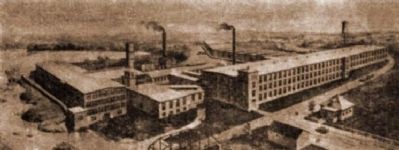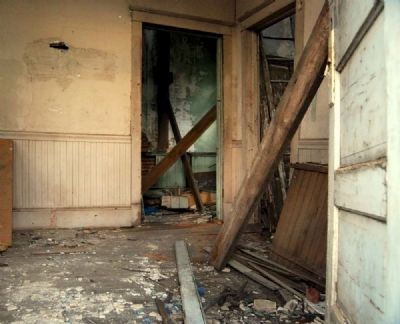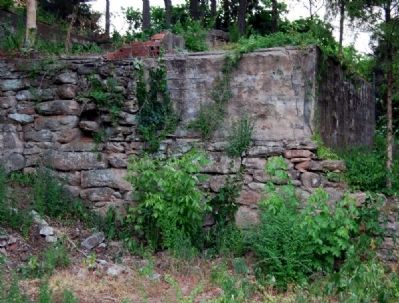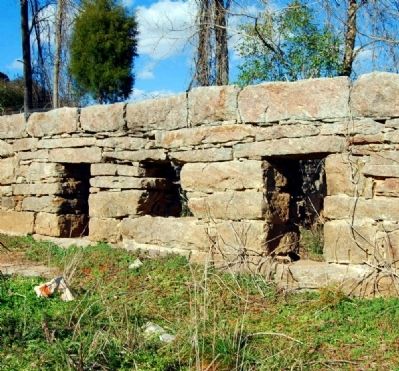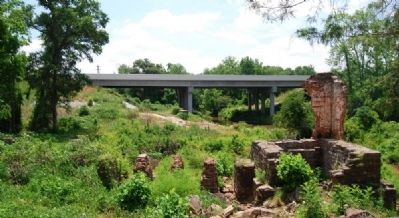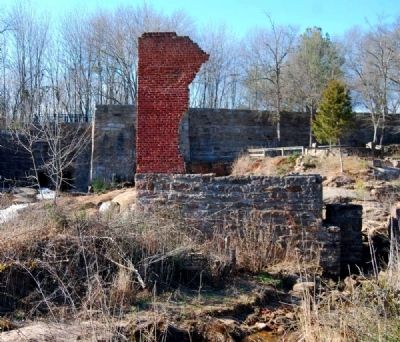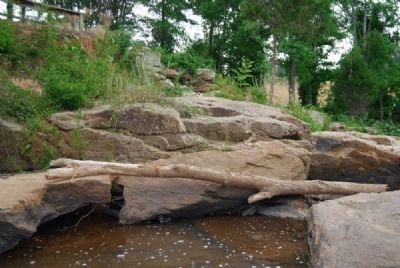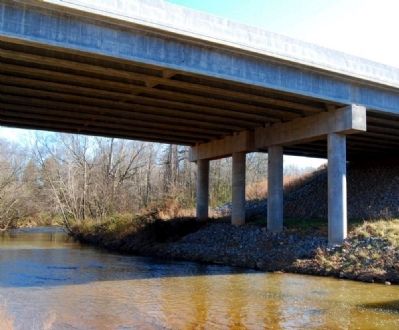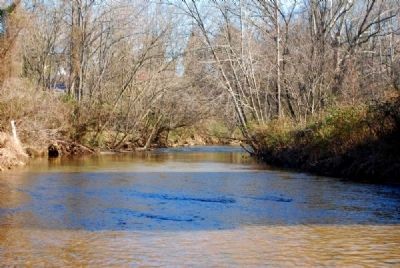Greer in Greenville County, South Carolina — The American South (South Atlantic)
Cotton Mills
By 1820 one of the first cotton mills in Greenville County was located at these river shoals. Pelham Manufacturing Co. purchased a mill here sixty years later.
Erected 1992 by Greenville County Recreation District. (Marker Number 23-21.)
Topics. This historical marker is listed in this topic list: Industry & Commerce. A significant historical year for this entry is 1820.
Location. Marker has been reported missing. It was located near 34° 51.4′ N, 82° 13.55′ W. Marker was in Greer, South Carolina, in Greenville County. Marker could be reached from State Highway 14. The marker is currently missing. It was removed when the bridge spanning the Enoree River was replaced. However, its text was documented in South Carolina Highway Historical Marker Guide, 2nd Edition, published by the South Carolina Department of Archives and History, 1998. Touch for map. Marker was in this post office area: Greenville SC 29607, United States of America. Touch for directions.
Other nearby markers. At least 10 other markers are within 5 miles of this location, measured as the crow flies. Pelham Mill (about 400 feet away, measured in a direct line); Cherokee Boundary (1767) (approx. 0.2 miles away); McClimons Memorial (approx. 2.3 miles away); Hugh Porter & Jane Baily McClimon (approx. 2.3 miles away); Early White Settlement / The Massacre of Jacob Hite (approx. 3 miles away); Flatwood (approx. 3.2 miles away); Graceland East Memorial Park Veterans Monument (approx. 3.2 miles away); Theron J. Hendrix Memorial Highway (approx. 3.8 miles away); Abner Creek Baptist Church (approx. 4.6 miles away); Birthplace (approx. 4.6 miles away). Touch for a list and map of all markers in Greer.
Also see . . .
1. Greenville County Recreation District: Pelham Mill Park. The Greenville County Historic Preservation Commission donated this 13 acre site bordering the Enoree River to the District in 1988. (Submitted on May 16, 2009, by Brian Scott of Anderson, South Carolina.)
2. Pelham Mills Site. The archaeological significance of the site of the twentieth century Pelham Mills factory and its nineteenth century precedents is that this resource embodies physical evidence of the birth and growth of the piedmont textile industry, which has been one of the major shapers of South Carolina’s present economic, social, demographic, and landscape character. (Submitted on May 16, 2009, by Brian Scott of Anderson, South Carolina.)
3. Enoree River. The Enoree River is a tributary of the Broad River, 85 mi (137 km) long, in northwestern South Carolina in the United States. (Submitted on May 17, 2009, by Brian Scott of Anderson, South Carolina.)
4. Arthur Barnwell House. The Arthur Barnwell House is reputed to have been built between 1880 and 1900 by the Pelham Manufacturing Company as a residence for its first president, Arthur Barnwell, in conjunction with Pelham Mills. (Submitted on May 17, 2009, by Brian Scott of Anderson, South Carolina.)
Additional commentary.
1. About Pelham Mill and Office
In 1816, Rev. Thomas Hutchings and others from Rhode Island traveled to Spartanburg in hopes of establishing a cotton mill on the Tyger River. Hutchings left the group, moved to Greenville, purchased 300 acres of land along the Enoree River from Charles Dean, and perhaps built his mill. There is documentation that a factory already existed on the property in 1820, but research is inconclusive as to the type of factory. After Hutchings' death, Josiah Kilgore and Philip C. Lester owned the mill. Eventually the mill was sold to Arthur Barnwell who renamed the mill the Pelham Manufacturing Co. The town, Buena Vista, was also renamed Pelham. The mill remained in operation until 1935 and
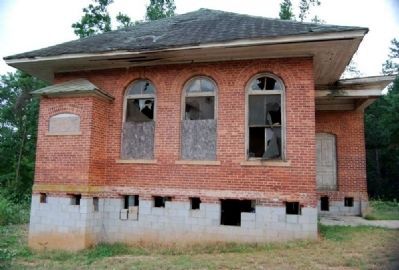
Photographed By Brian Scott, June 20, 2008
3. Pelham Mill Office - North Side
Western Carolina Regional Sewer Authority took an active role in preserving a historical landmark in the Upstate. On September 11, 2002, historic Pelham Mill office building was moved onto land leased by Western Carolina to the County Recreation District for only $1 a year. This one-story brick building was believed to be built around 1870 and was used as the Pelham Mill’s office until the textile plant closed in 1930. The building became a Pelham Post Office until its closing in 1996. Since the building was never placed on the historical register, it would have been demolished if Western Carolina had not stepped in to help.
— Submitted May 16, 2009, by Brian Scott of Anderson, South Carolina.
2. Manufacturing History of Pelham Mills Site
What is thought to have been the first cotton factory in Greenville District was established by the Reverend Thomas Hutchings. Primarily known during the nineteenth century as the Buena Vista factory, this cotton mill was also called the Hutchings Factory and later, the Lester Factory, and was associated with the establishment and growth of the town of Buena Vista (now Pelham), South Carolina. After 1880, the factory was known as Pelham Mills.
Rev. Hutchings immigrated to South Carolina in 1816 from Rhode Island as one of a small group of men who sought to establish a cotton factory in Spartanburg District. Like other members of this group, Hutchings soon left the Spartanburg factory to establish his own mills in Greenville District. In 1820 he purchased 307 acres from Charles Dean and within two months was operating a small factory.
Although Hutchings' tenure at the Buena Vista factory was short-lived, it was a successful operation which initially housed a 144-spindle cotton mill. Establishment of a second mill building at the site soon followed, with Hutchings obtaining a mortgage in 1821 to secure finds for the purchase of machinery. A New Englander himself, Hutchings no doubt modeled his early Buena Vista cotton factory after the early New England textile factories. The mill buildings were probably built of wood on mortared stone foundations. After the larger of these two buildings burned in the 1820s, Hutchings rebuilt on the same site and continued to operate the Buena Vista factory for a few years.
In 1827, however, Hutchings was forced to sell his property to Philip C. Lester, who, along with Josiah Kilgore, had probably helped finance the rebuilding of the factory. Lester and Kilgore became partners in the Buena Vista factory after Lester's purchase, and expanded its operation until 1853. By 1850 their investment in the real and personal estate of the Buena Vista factory was worth $20,000. In that year the mill employed five men and 20 women, who produced $12,000 worth of cotton yarn.
Shortly thereafter, in 1853, the Buena Vista factory burned again. the fire caused the uninsured partners to suffer a loss of $12,000 in structure and machinery. In 1853, Lester burned out Kilgore's half-interest, rebuilt the burnt structures, and installed about 500 spindles. Lester's sons, W.F., Archibald, and George, joined him as owners of the Buena Vista factory
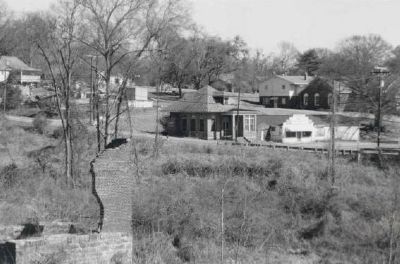
Greenville County Library, Carolina First Reading Room, 2001
5. Pelham Mill Office - Original Location on Highway 14
The Greenville County Council voted in 2009 to appropriate $100,000 in restaurant tax money to the proposed restoration of the Pelham Mills Park. The plans include trails, historic markers and a dog park on the former mill site.
It appears that the village of Buena Vista, a mill town including houses for factory workers, was in existence by 1860. The remnants of this village are incorporated today in the town of Pelham.
The Lester firm, which became Lester & Brothers after Philip Lester's death, continued to expand its Buena Vista factory during the 1860s. despite the onslaught of the Civil War. No doubt because it served a desperate need for Confederate yarn, the mill employed 30 persons and operated 840 spindles for 1867. Despite the war's end, anticipation of doubled capacity by 1868 appears to have been realized, and by 1870 the factory employed 57 women and men, and operated 1,500 spindles and an unspecified number of frames. Lester & Brothers was equally successful in its other manufacturing operations in Greenville County, including the gristmill, sawmill, blacksmithy and cotton gin.
Although the Buena Vista factory prospered and expanded between 1830 and 1870, Lester & Brothers apparently did not invest sufficient capital to modernize its outmoded machinery. For this reason more than any other, the Buena Vista factory declared bankruptcy in 1880:
"This factory, while like the Batesville, acquired considerable prominence during the war, is now under the cloud of a lawsuit and is not running. Its capacity is 2,000 spindles and 40 looms. The machinery is all old fashioned, and the building itself is somewhat dilapidated. It is nevertheless a valuable piece of property. By a recent decree of the Court the portion of the property in Greenville County has been ordered to be sold shortly, and the portion in Spartanburg County is still in possession of the creditors of Lester & Bobo, the former owners. The water power under control is estimated at 100-horse power, and the entire property includes 600 acres of land. If purchased by the right sort of man, the property can be made very valuable and profitable."
In fact, the Lester factory was not unlike others in the Greenville area which failed between 1880 and 1885. As a result of rapid advances in cotton manufacturing equipment and processes, the older factories faced stiff competition from large new establishments. Between 1880 and 1895, the number of spindles operating in South Carolina increased seven-fold (95,935 in 1880 to 775,224 in 1895), but Greenville County's share of the industry fell from 31.7% to less than 10%.
The real property of Lester & Brothers was sold in 1880 at public auction for $13,400 to the Pelham Manufacturing Company. This sale encompassed 303 acres of land, upon which all of the existing mill buildings (housing spindles, looms, and other machinery), gristmill, and the former home of Philip C. Lester were located. Pelham Manufacturing Company, headed by New York Banker Arthur Barnwell, was a prosperous and influential operation. In the same year that the company purchased the Buena Vista factory, the name of the mill village was officially changed from Buena Vista to Pelham, and by 1882 the factory was known as "Pelham Factory at Lester's Bridge."
In 1882 Pelham Manufacturing Company incorporated its Greenville County operation under the name "The Pelham Mills." In that year, the mill employed 60 persons and operated 2,032 spindles, or slightly more than the Lester & Brothers factory at its zenith around 1870. The corporation existed for the purpose of: "manufacturing, spinning, dyeing, printing, and finishing and selling all kinds of goods of every description or kind made of wool or cotton, or which wool or cotton or other fibrous articles may form a part, and any other articles of any nature or kind whatsoever which they may from time to time desire, and for grinding or milling wheat, corn, and other grains, sawing lumber and selling merchandise and for producing and making all machinery, tools and implements necessary to or used for such purposes, and may erect such mills, buildings, gins, machine shops, stores, dwellings and other works as may be required or be necessary to carry out such branches of manufacturing and business."
Despite construction of a large, mortared stone dam between 1880 and 1890 to better control the river flow, Pelham Mills was damaged by flooding in 1890. Shortly after this flood, the mill office was moved to its present location.
By 1907, after 20 years of steady growth, Pelham Mills was operating 10,752 spindles for the production of cotton yarn and twine. The mill village housed 500 persons, and the factory employed 300 workers, including three children under the age of 12. It is interesting to note that although the company school provided six grades of education and many children entered the textile work force upon completing grade school, children younger than 12, particularly those with siblings already employed in the mills, were often allowed to work in the factory. In these cases, grade school education ended as early as the third grade.
In 1906-1907, Pelham Mills posted an annual payroll of $50,000. During that year, 4,359 bales of cotton were processed to produce yarn valued at $329,850.42. The mill continued to produce yarn, twine, and knitted goods (primarily cotton socks and stockings) throughout the remainder of its operation.
In order to streamline its operation and complete with newer mills in the state, Pelham Mills supplemented its water-powered machinery with steam power; this conversion was in place at least by 1919. As expansion in yarn production slowed after 1907, the company added a dyeing operation (1919). In 1922 the number of spindles in operation dropped significantly (10,752 in 1919 to 10,156 in 1922), but the dyeing plant remained in operation. Capital stock invested in the company ($400,000) in 1922 was only slightly greater than that posted in 1907.
By 1935 production of cotton yarn, rope, twine, and knitted goods had again increased to 11,112 spindles, and capital stock had risen to $500,000. The factory was powered by steam and water until it ceased operations later that year. The mill was vacated between 1936 and 1940, after its machinery wad reduced and sold for scrap to a metal salvage company. During this period, residential lots in the Pelham Mills village were offered for sale, first to mill workers, and then to the general public.
In the early 1940s, an accidental fire in one of the factory buildings destroyed the entire mill complex for the third and last time. Although all the machinery had been removed by that time, the fire destroyed a number of cotton bales and packages of knit goods which were stored in the warehouse.
In 1979, the mill property was purchased by U.S. Shelter Corporation which recently deeded 6.8 acres containing the Pelham Mills ruins to the Greenville County Historic Preservation Commission. (Source: National Register nomination form.)
— Submitted May 17, 2009, by Brian Scott of Anderson, South Carolina.
3. Village Houses at Pelham Mills
The village houses at Pelham Mills community were sold during the war years by J.P. Williamson and M.S. Merritt & Rush Realty Company. The Pelham houses were priced modestly and could be bought on terms. Dennis Grubbs was living on J Street when the opportunity came for him to buy the house he had lived in for years. He bought his house and lot overlooking the Enoree River for $260, financing the purchase through the realtor with a down payment of $15 and $6 payments at 6% interest. Payments were made directly to the realtor in the Pelham Mills office, which has remained open to receive rent payments and settle accounts since the mill closed. Claude B. Cannon, office clerk, remained as an agent for the reality company to receive monthly payments through the war years. The only restrictions on the property were that the buildings could not be removed without consent of the seller nor could ant conveyance, lease or occupancy by a colored person be permitted. (Source: Greenville County,
South Carolina: From Cotton Fields to Textile Center of the World by Ray Belcher (2006), pg 124.)
— Submitted May 17, 2009, by Brian Scott of Anderson, South Carolina.
4. Pelham Mills Church and School
At the Pelham Mills the church was erected entirely at the expense of the president of the corporation, and the company pays about one-third of the total expenses of conducting the services. The membership of the church is about two hundred and the average attendance fully three hundred.
The school at Pelham is supported entirely by the cotton mill, the company appropriating $400, the necessary building fuel, light for the school. The building was constructed at the expense of the corporation. The county makes no contribution for the support of the schools. The Pelham Mill has a club house and gymnasium for the pleasure of its help. (Source The Cotton Mills of South Carolina by August Kohn, pg 167.)
— Submitted May 17, 2009, by Brian Scott of Anderson, South Carolina.
Credits. This page was last revised on January 18, 2021. It was originally submitted on May 16, 2009, by Brian Scott of Anderson, South Carolina. This page has been viewed 3,733 times since then and 105 times this year. Photos: 1, 2, 3. submitted on May 16, 2009, by Brian Scott of Anderson, South Carolina. 4, 5. submitted on May 17, 2009, by Brian Scott of Anderson, South Carolina. 6, 7, 8, 9, 10, 11, 12, 13, 14. submitted on May 16, 2009, by Brian Scott of Anderson, South Carolina.


